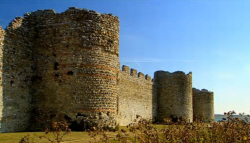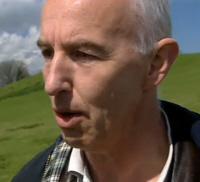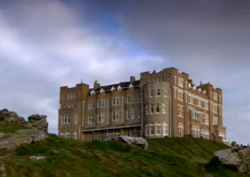King Arthur’s Britain
Cadbury Castle
Britain AD: King Arthur’s Britain

Battle Site
Using the latest archaeological research, I’m going to tell the real story of Britain from the perspective of the people on this island during this period.
I’m going to start with the first chapter of Britain A.D. – the Roman occupation of Britain.
This peaceful corner of Somerset is the site of one of Britain’s earliest and bloodiest battles and it’s evidence for the crushing
of our ancestors in the early years in Britain AD.
For hundreds of years before the Roman conquest, this dramatic hillfort was a religious centre for ancient Britons. When the Roman conquerors
arrived, the people here were ready for them.
The banks on the side of the hill are the remains of ramparts that stood five metres high. But the hillfort was not designed to face the disciplined
Roman army. The defenders were driven back and the gates set alight. The Roman troops stormed through the burning gateway and slaughtered the Britons
– men, women and children were cut down, and their bodies were left to rot.
After this massacre, the Roman troops destroyed fields and farmland, a clear message to the Britons not to mess with the might of Rome. The events at
Cadbury Castle tell a familiar story of the native Britons as tragic victims.
It’s a story that fits well into the conventional narrative of Britain A.D.
I’m going to show you that this version of our past is wrong.

Cadbury Castle
The first few centuries of Britain A.D. saw the forging of our national identity. Archaeology is beginning to show that far from a Dark Age,
this was a time of huge creativity and development. The legacy of Roman Britain has stopped us understanding this period. In order to appreciate
the significance of these times, we must go back to the archaeology. The archaeologists excavating at Cadbury Castle didn’t only find evidence
of a Roman massacre. They also found building foundations from soon after the Roman occupation. This confirmed what I had thought – that the
ancient British culture was strong. The twist is, the archaeologists were looking for Arthur’s Camelot.

Dr Nick Higham
Dr Nick Higham “The locals believed this was Camelot. They’d been panning this field, coming up with all sorts of stuff, most of it Iron Age,
some Roman. They thought it was a battle site. And then, small-scale excavation comes across massive refurbishment of the fortifications in roughly
the right period. They come across a timber-framed Hall in the middle with loads of Mediterranean-type pottery scattered about. The fact that
there is already a connection with Arthur’s name means that the whole thing is ready to roll.”
Could Arthur be a clue to what happened in Britain A.D.?
Trouble is, Arthurian archaeology is more than a little short of proof. There isn’t a corner of Britain that doesn’t claim a connection with
this historical celebrity.

Camelot
This is where Arthur is supposed to have been conceived. And this is Arthur’s footprint. This is Bossiney Mound – King Arthur’s round table is
buried here and every year, on Midsummer day, it levitates! And this is our first Camelot.
This is Slaughter Bridge where Arthur finally kicked the bucket before being carted off to Avalon.
As an archaeologist, I’ve always been rather sceptical of the Arthurian industry. Arthur is the ultimate commodity – a ready-made hero who’s
been hijacked by history.
I’m in a dramatic visitor attraction in the Shropshire countryside – the complete Arthurian package. There’s a lake with the legend of the
sword Excalibur. I’m standing in Arthur’s Grotto where someone claims they found the holy Grail. There was even a stone with a sword in it, ’til
someone nicked the sword.
Arthur encapsulates so many good qualities that we really want to identify with.
Nick Higham “Arthur’s the great warrior figure, and he’ll come back to save us when the nation is at its greatest peril and that sort of story
has an enormous attraction.”
This gripping tale of dark age Britain has fired the imagination of writers and artists for centuries, and it would be easy to dismiss it as a
fairytale with no grounding in history. But myths are not necessarily lies. Stripped of his mediaeval embellishments, Arthur has new things to tell
us about this period. The idea of noble Arthur conflicts with the conventional view of the barbaric dark ages, and supports my view that British
culture survive the Romans intact. And at the heart of Arthur story, I found a clue to the resilience of the native Britons in the aftermath
of Roman rule.

Excalibur
The myth of the sword Excalibur holds a clue to what really happened in Britain A.D. The story of King Arthur is not a happy one. It involves
an illegitimate boy raised by a magician called Merlin. The boy becomes King and assembles a loyal following of 12 men known as the Knights of the
Round Table. King Arthur and his knights fight many gallant battles but eventually Arthur is killed. His body is taken to the magical island of
Avalon where legend has it that Arthur is not dead but sleeping, waiting for a time when his kingdom will need him again.
Throughout the many different versions of this story, there is a potent image that comes back again and again. Swords play a central role in
the Arthurian legends. He learns that he is to be the king of Britain when he miraculously withdraws a sword from a stone. At the end of his life,
his magical sword Excalibur is returned to a goddess in a lake. As a pre-historian, all this sent a shiver of recognition down my spine.
The image of Arthur pulling his sword out of the stone was an eerie reminder of the ancient practice of casting bronze. I have witnessed this
process. The orange glowing sword is initially pulled from a stone mould. In my work as a pre-historian, I had discovered ritual traditions in which
weapons were disposed of in watery places, and where islands had particular potency.
How did these ancient British traditions find their way into the story of King Arthur, written centuries later?




